|
1.
CENTRAL/ WEST AFRICA
Timber trade firming
After a short quiet trading period while importers assessed
their mid-year stock and forward position, the log market
has become active once more. China has resumed regular
purchases from Cameroon, Congo Brazzaville and smaller
volumes are also being gathered from Equatorial Guinea
and Democratic Republic of Congo.
Because of reduced exports of some heavy hardwood
sawnwood from Brazil and other South American
exporting countries, there has been a welcome increase in
demand from European importers for iroko, which has
raised both log and sawnwood prices.
Sapele is also in good demand and sawnwood output has
been increased to cope with the higher level of orders.
Prices for sapele logs and sawnwood are up and firming.
Sipo sawnwood has experienced some increase in demand
as European importers are now more comfortable to
rebuild their stocks in preparation for the expected
improved demand over the second half of the year.
Whilst housing starts in Europe have not yet recovered,
there is better demand for hardwoods from a more active
renovation and home improvement sector. As importers¡¯
stocks are low, this sector is the main reason for recently
improved demand for tropical hardwoods. In addition,
prices for West and Central African timbers are still very
reasonable in comparison with some American and
European temperate hardwoods.
Lack of investments in sawn mill business
Some exporters are still hoping that the government of
Gabon will review the log export ban. However, the
authorities in Gabon have indicated that all logs remaining
in the port must be removed.
Sawmills in the region have strong order books. However,
there has not been any news on investments to increase
production capacities for sawnwood or downstream
products. The market failures experienced over the past
two years have discouraged investors from diversifying
production.
Moreover, the continued uncertainty over the Gabon
situation is not conducive for investors to make any longterm
expansion plans. Also, uncertainty means that the
importers are unable to assess the future raw material
supplies for their in-country processing industries.
Incentive to obtain full certification
When the new EU import regulations on illegally
harvested timber imports come into force in 2012, they
will work as an incentive to African timber producers to
obtain full certification.
Consumers in EU, however, must be prepared to meet
higher prices due to costs of the certification process.
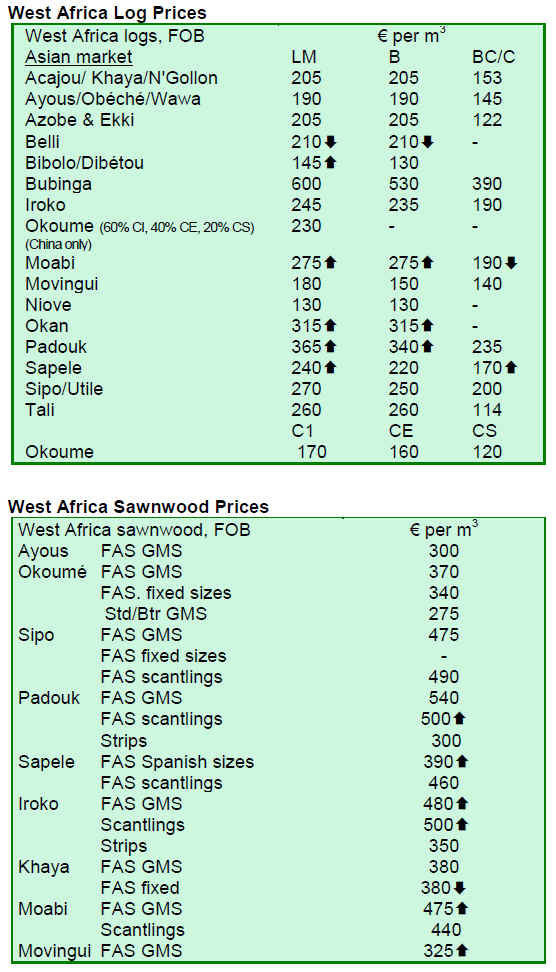
2. GHANA
Call for review of utility tariff
The Ghana timber industry has added its voice to others
who are demanding a downward review of the utility tariff
which was recently raised by the Public Utility Regulatory
Commission.
At a meeting between the Ghana Timber Millers
Organisation and the Timber Workers Union in Accra, the
millers claimed that the higher tariffs leave them no other
option but to lay off workers in order to stay in business.
The timber operator¡¯s call came at a time when the Trades
Union Congress has urged the government to reset the
previous tariff levels.
According to the timber industry, sharp increases in the
industry¡¯s major costs, especially in electricity tariffs, have resulted in some closures in timber sector over the past 5 years. In addition, the industry has suffered from
operational taxes such as the National Reconstruction
Levy and high interest rates.
The timber industry in Ghana contributes about 7% to
GDP and it is the fourth biggest industry in terms of export
revenues.
Inflation eases to single digit
According to the Ghana Statistical Service, Ghana¡¯s
inflation fell to 9.52% in June 2010, down 1.16 percentage
points from May 2010. Inflation has now declined for the
12th consecutive month.
Consequently, the Monetary Policy Committee decided to
reduce its Policy Rate to 13.5%, the fourth consecutive cut
since November 2009.
In another development, the commercial banks in the
country have followed the Policy Rate and reduced their
lending rates for businesses.
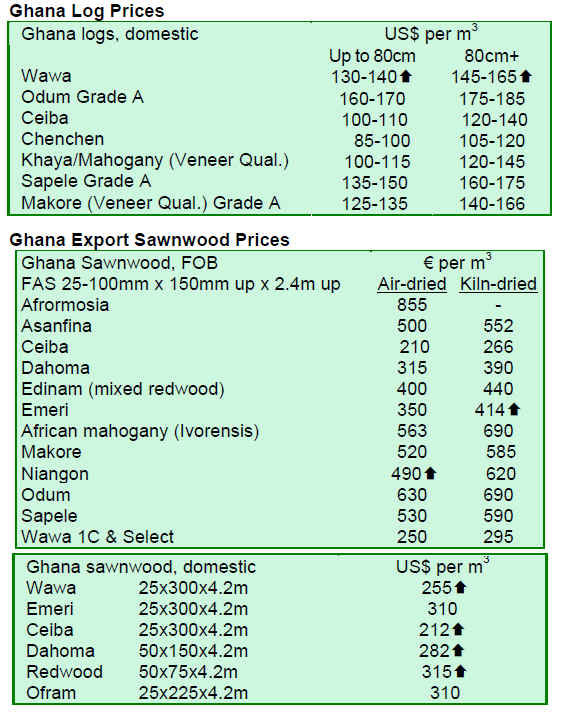
3.
MALAYSIA
Upward trend in timber product exports
The exports of timber and timber products from Malaysia
reached RM8.5 billion in the period from January to May
2010, 17.4% higher than the RM7.3 billion recorded in the
same period last year. The Malaysian government
expressed confidence in reaching the timber product
export target of RM22 billion for the current year.
South Korea set antidumping duties on plywood
South Korea has imposed preliminary antidumping duties
on imported Malaysian plywood. The South Korean Trade
Commission (KTC) opened a dumping investigation after
receiving a petition from the Korean Wood Panel
Association that some plywood manufacturers in Malaysia
are selling their products below the production cost and so
hurting local South Korean plywood manufacturers. The
plywood market in South Korea valued at US$584 million
in 2009.
Imposed duties range from 5.11% to 33.81% on plywood
imports from Malaysia. These preliminary antidumping
duties are in effect until a formal ruling is made within the
next 5 months.
Some Malaysian plywood manufacturers expressed the
fear that the Japanese government may follow the South
Korean example and impose antidumping duties on
Malaysian plywood.
Malaysia¡¯s trade with South Korea
Plywood is one of the main exports from the East
Malaysian state of Sarawak and the plywood antidumping
duties imposed by the South Korean government are
anticipated to have a significant impact on plywood
production in the state. The Malaysian Deputy Prime
Minister visited South Korea recently addressing the issue
of bilateral trade, amongst others.
Malaysia¡¯s foreign trade with South Korea contracted
from US$15.1billion (RM49.83billion) in 2008 to
US$11.7billion (RM38.61billion) in 2009.
However, there are signs that bilateral trade between the
two countries is recovering. From the beginning of the
year trade has soared 47% over the last year¡¯s level
reaching now US$6.6 billion. South Korea is Malaysia¡¯s
sixth largest trading partner and seventh largest export
destination.
Shortage of labour clouds the furniture sector
At the recent Malaysia Furniture and Furnishing Fair 2010
(MF3), the Ministry of Plantation Industries and
Commodities announced that the current exhibition is
expected to generate RM50 million in sales compared to
RM45 million in 2009.
Furniture exports from Malaysia are projected to reach
RM7.4 billion, a 20% increase from 2009 with RM6.2
billion.
Meanwhile, the furniture industry in Malaysia is losing
millions of dollars in revenue as it struggles to overcome
the shortage of manpower, a crucial factor in the labour
intensive furniture industry which depends heavily on
foreign workers. This, in turn has forced furniture
manufacturers to operate below capacity which is causing
international buyers to turn to other countries to fulfil their purchasing requirements.
A roundtable discussion between various ministries will
take place to address the problem of foreign labour
shortage in Malaysia.
Market forecast ¨C increase in prices
Rainy weather and a recent increase in fuel prices pushed
Malaysian timber product prices up during the past few
weeks.
After a slight downturn, freight costs are expected to rise
significantly between 10% to 20%. In addition,
manufacturers are worried about how to adjust product
prices to reflect the increased costs without undermining
their marketing.
As a result of rising fuel prices, logging operators are also
expected to raise harvesting charges as the work is highly
dependent on heavy machinery.
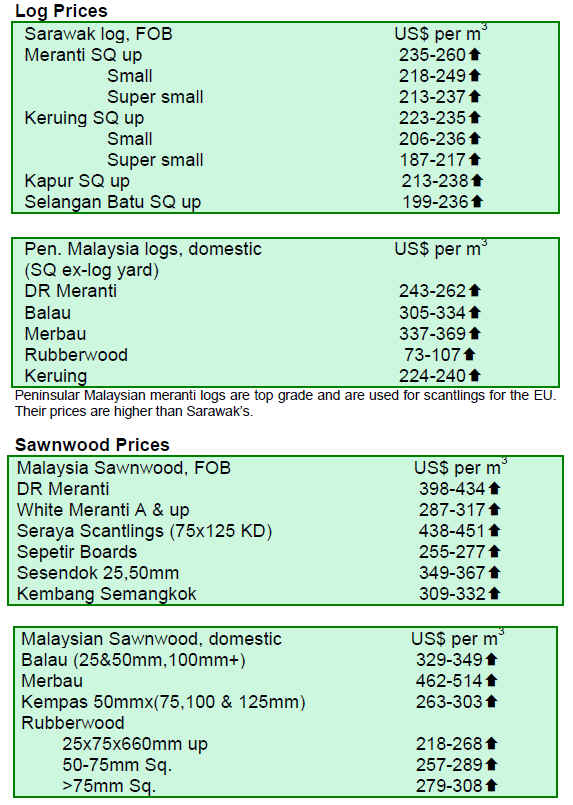
4.
INDONESIA
Proposal to extend moratorium on conversion of
peatlands
The Indonesian government has prepared draft legislation
to extend the 2-year moratorium on conversion of
peatlands by an additional 3 years. The proposed 5-year
moratorium would affect the palm oil sector which has
been clearing and draining peatlands to expand
plantations. As the 2-year moratorium on new permits to
convert natural forests remains, there might be an
increasing risk that the Indonesian palm oil plantation
companies increase demand to clear natural forests when
the moratorium covering natural forests is lifted as the
moratorium on peatlands would still have three years to
run.
The initial 2-year moratorium on conversion of peatlands
is said to be insufficient to address sustainable peatland
management and so substantially reduce greenhouse gas
emissions. According to the draft legislation, the
government will re-examine all peatland concession
permits, including existing ones.
There are over 21 million hectares of peatlands in
Indonesia: 8 million hectares in Papua province, 7.2
million hectares in Sumatra and 5.8 million hectares in
Kalimantan. It is estimated that Indonesia¡¯s peatlands
contain 46 gigatonnes of carbon.
Rattan industry under threat
The Indonesian Rattan Foundation (YRI) claims that
inadequate rattan export policies and declining demand for
Indonesian rattan products may threaten the existence of
the rattan furniture and handicraft industry in Indonesia.
The international rattan product market was valued at
around US$100 billion in 2008 and US$104 billion in
2009. However, Indonesia was only able to generate
export revenues of US$2.6 billion and US$2.3 billion in
2008 and 2009 respectively.
YRI added that the number of rattan processing units
continues to drop. In addition, the ban on raw rattan
exports has affected the lives of 2.3 million rattan
collectors and farmers. The domestic industry processes
between 30,000 to 40,000 tonnes of rattan per year, while
the industry has a production capacity for close to 700,000
tonnes per year, says YRI.
Rattan is said to have a potential to generate revenues up
to US$4 billion per year, providing jobs for about 5
million people.
Expansion of paper and pulp industry
The Indonesian Ministry of Industry revealed that the
government is considering expansion of the paper and
pulp industry into Eastern Indonesia, including Papua.
Currently, the Indonesian paper and pulp industry is
concentrated mainly in Western Indonesia.
Indonesia is the ninth largest pulp producer and eleventh
largest paper producer in the world. A total of 14 pulp
manufacturers have a capacity to produce 7.9 million
tonnes of pulp a year, and 81 paper manufacturers¡¯
production capacity is 12.17 million tonnes of paper.
In 2009, pulp production in Indonesia reached 6.52 million
tonnes and paper production totalled 9.31 million tonnes.
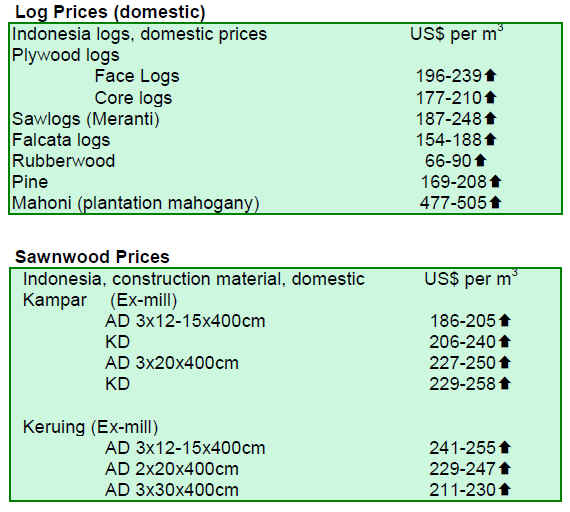
5.
MYANMAR
Mixed market signals
During the second half of July, some traders in Myanmar
reported that the market demand for teak, pyinkado and
Gurjan logs remains sluggish as China, among others, is
placing smaller orders. Shipments in July were down
compared to last month but some increase was recorded
towards the end of the month.
Analysts suggest that there are some teak dealers in India
who are selling the previous year's SG-7 (ER1) teak logs
at very low prices while other dealers are selling fresh
stocks at higher prices. This is said to be causing some
confusion in the Indian market.
Country-wise purchases during July
Country-wise purchases of Myanmar hardwoods during
July 2010 were as follows: Singapore (2 buyer, 85 Hoppus
tons) and Thailand (3 buyers, 283 Hoppus tons). In the
domestic markets there were four buyers and the timber
sales totalled the amount of 214 Hoppus tons.
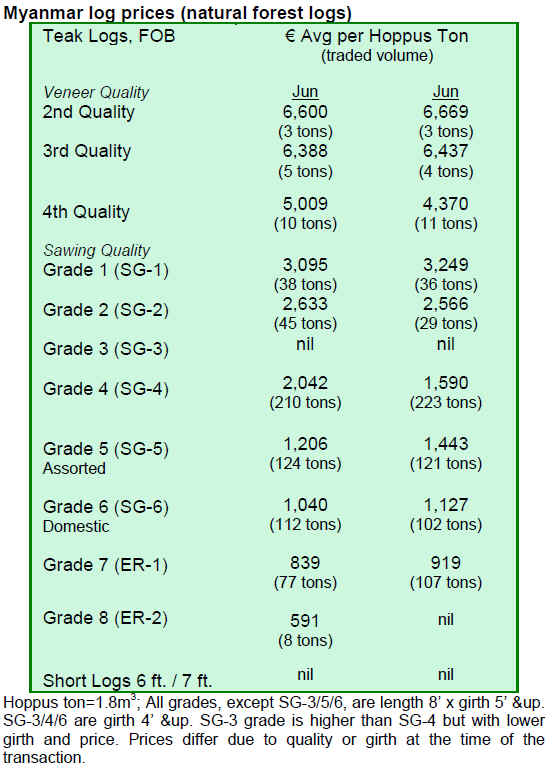
6. INDIA
Exports of plywood and panels
While overall Indian exports are registering growths of
around 30% that is not the case with wood-products.
Continuous weak demand in North America and Europe is
said to be the reason for the poor export performance of
the wood products sector.
Nevertheless, last year¡¯s wood product export levels are
expected to be maintained. Indian exporters are
continuously making efforts to expand their markets.

Teak auction sales in Central India
Auction sales in various depots of Madhya Pradesh
continued. The total sales of teak logs were around 4000-
5000 cu.m. The average teak log prices at the latest
auctions were as follows:
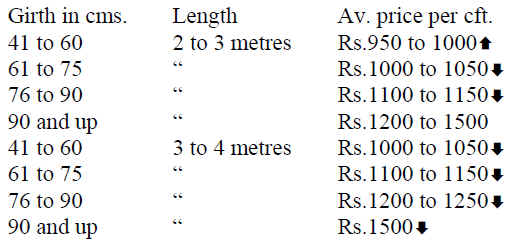
The monsoon season has still not started in Central India
and thus more log auctions are expected to be held as
logging can continue and the supply from the forest is
good.
As the monsoon season continues in Western India, the
Forest department and NGOs are implementing tree
planting programmes. This year the programme seems to
be particularly popular in terms of number of participants,
perhaps due to increased environmental awareness in
India.
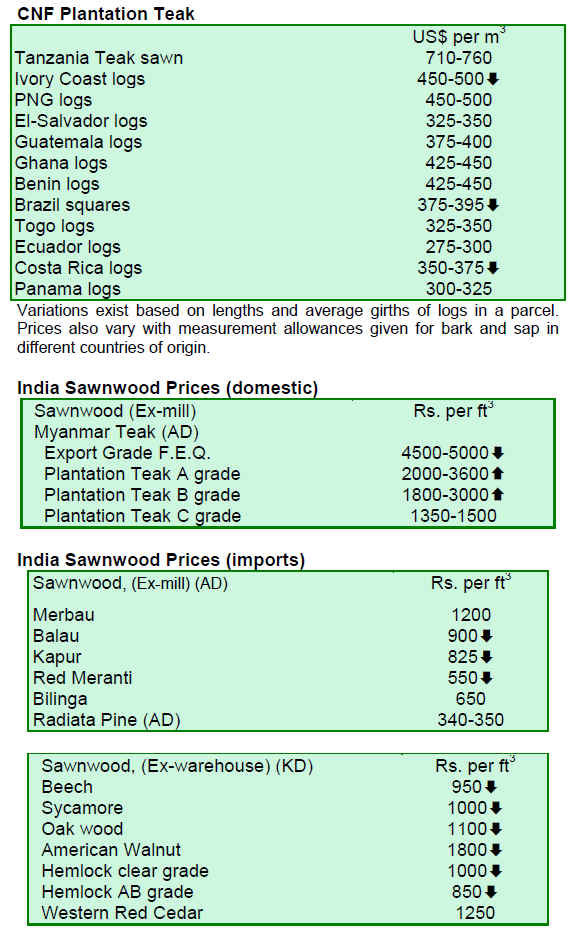
7. BRAZIL
Tropical timber exports remain dull
In June 2010, exports of timber products (except pulp and
paper) increased by 19% from US$173 million in June
2009 to US$206 million.
Exports of tropical sawnwood decreased in terms of both
volume and value, from 40,400 cu.m in June 2009 to
38,500 cu.m in June 2010 and from US$18.6 million to
US$17.9 million. This translates to a 4.7% decrease in
volume and a 3.8% decrease in value.
Exports of tropical plywood decreased from 11,000 cu.m
in June 2009 to 8,700 cu.m in June 2010, representing a
21% decline. In value terms, the drop was 16%, from
US$5.8 million to US$4.9 million.
Pine sawnwood exports dropped 12% in June 2010
compared to the June 2009, from US$ 11.4 million to US$
12.8 million. In terms of volume, exports decreased 3.5%
from 57,500 cu.m to 55,500 cu.m over the period.
The value of pine plywood exports jumped 109.8% in
June 2010 compared to the level in June 2009, from
US$17 million to US$37 million. Export volumes
increased by 36% during the period, from 71,900 cu.m to
97,600 cu.m.
For wooden furniture, the value of exports rose by 10.5%
compared to the level in June 2009 to US$47 million in
June 2010.
Furniture industry forecasts growth in 2010
The reduction of the tax on industrial products from 10%
to 5% has encouraged the furniture sector, according to the
Brazilian Furniture Industry Association (ABIMÓVEL).
The tax reduction is expected to generate a 10% growth in
the sector for this year.
In 2008, Brazilian production of wood furniture reached
R$22 billion. In 2009, sales fell 18% to about R$18 billion
due to the global economic crisis. ABIMÓVEL expects
that the furniture sector achieves the 2008 performance
this year. In December 2009, the sector already
experienced some recovery. According to ABIMÓVEL,
sales rose 13% and mills increased their production from
70% to 85% of the total production capacity.
The largest trade fair of wood-furniture industry suppliers
in Latin America, the ¡°ForM¨®bile¡¯¡¯, was held in São Paulo
between 27-30 July. The fair brought together about 750
exhibitors from around thirty countries representing
sectors such as machinery, raw materials, components,
decorative accessories and services.
Brazilian furniture exports pick up
Brazilian furniture exports in the first half of 2010 totalled
US$ 368 million. Argentina was the major importer at
US$55 million, representing a 106% increase over the
same period of last year. Second biggest importer was the
US at US$ 44 million importing 7.5% less than in the
same period last year, followed by France (US$ 38.7
million) a 16% increase in the period.
Santa Catarina, the main furniture exporting state in
Brazil, increased its exports by 11.4%, totaling US$ 126.5
million which represents 34.4% of the total Brazilian
furniture exports.
Rio Grande do Sul exported US$96 million in the first half
of 2010, accounting for 26% of the total furniture exports
from Brazil. The United Kingdom was the main importer
with US$15 million, accounting for 15% of the state¡¯s
total exports, followed by Argentina with US$11 million,
a 10% share of the total furniture exports. Exports from
Rio Grande do Sul to the US decreased by 7%, now
accounting for 6% of the state¡¯s total furniture exports.
São Paulo exported 31% more in the first half 2010
compared to the same period last year, totaling US$ 65.2
million and constituting about an 18% share of the total
exports of Brazilian furniture. Paran¨¢ exports rose by 29%
in the first half of the year, accounting for 14% of the
Brazilian total furniture exports. Minas Gerais had the
highest growth in furniture exports with 121% increase in
the first half, however, Minas Gerais furniture exports
represent only 3.9% of the Brazilian total furniture
exports.
Timber product prices
The price average of timber products in Brazil increased
slightly from the last fortnight. However, the prices quoted
in the US dollars fell due to a slight depreciation of
Brazilian currency against the US dollar.
Satellite monitoring of concessions
The Brazilian Forest Service (SFB) and the National
Institute for Space Research (INPE) signed a technical
cooperation agreement to monitor logging in forest
concession areas. The implementation is planned to start in
forest concessions of the National Forest of Jamari and
Rondônia by the end of 2010.
SFB will use satellite images provided by INPE to monitor
whether companies are logging only in authorised forest
areas according to forest management plans. INPE has
also started a remote sensing training programme in digital
image processing for the Forest Service technicians.
Based on satellite monitoring and spatial information, SFB
will be able to identify timber yards and forest roads
opened for timber transportation within the forest
management unit, as well as any logging outside the
designated area.
Timber companies¡¯ concerns in Par¨¢
In the period from January to May 2010, wood product
exports from Par¨¢ increased 10% compared to the same
period last year. Timber product exports totalled 161,000
tonnes, US$161 million in value.
However, producers are not satisfied with the numbers
because exports are still 50% lower than recorded in 2008,
before the economic crisis. The timber companies believe
that as the US house construction sector recovers from the
crisis, demand for tropical timber from Par¨¢ will grow.
Besides the continued economic depression, another factor
causing weak export performance is the appreciation of
the Brazilian Real against the US dollar. To ease the
situation, Brazilian timber companies have requested the
government to address the problems of raw material
shortage and excess bureaucracy on timber operations.
Economic growth remains stable
According to the Brazilian Institute of Geography and
Statistics (IBGE), the Consumer Price Index (IPCA) of
June 2010 remained unchanged at 0.43%. The pace of
inflation has eased from the first months of the year but is
still well above 0.36% recorded in June 2009. The record
low for the IPCA was chalked up in June 2006 when there
was a 0.21% deflation.
In an attempt to keep inflation within the target range, the
Copom (Economic Policy Committee) raised the prime
interest rate (Selic) by 0.5 percentage points to 10.75% per
year. The prime interest rate was already raised by 0.75
percentage points in June.
In June 2010, the average exchange rate was BRL
1.81/US$, while it reached BRL 1.96/US$ in the same
month of 2009, which shows increasing appreciation of
the Brazilian Real against the US dollar over the period.
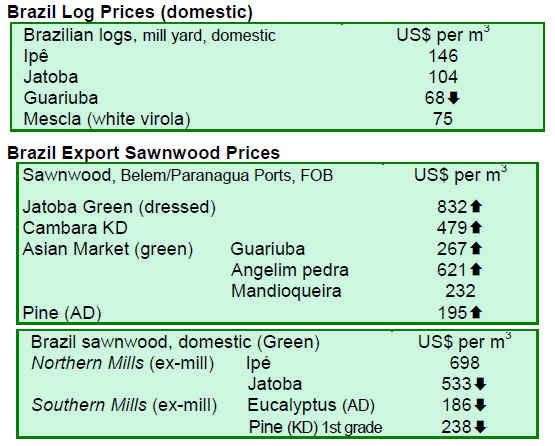
8.
PERU
National export quota for mahogany
The Agricultural Ministry (MINAG) approved the national
export quota for mahogany (Swietenia macrophylla) for a
total of 720 trees coming from 19 forest concessions with
verified Annual Operating Plans (POAs). The quota came
into effect from 23 July and will be in effect for the next
12 months.
The approved quota is based on a report assessing the
mahogany situation in Peru. The assessment was prepared
by the National Agricultural University of La Molina
which is also the scientific authority for the Convention on
International Trade in Endangered Species of Wild Fauna
and Flora (CITES) in Peru.
The report recommends that the national sustainable
export quota for mahogany is 831 trees a year. The report
also suggests that the timber is harvested only from the
forests with approved POAs, declaring standing trees,
sustainable annual harvest, density of seed trees and
regeneration operations.
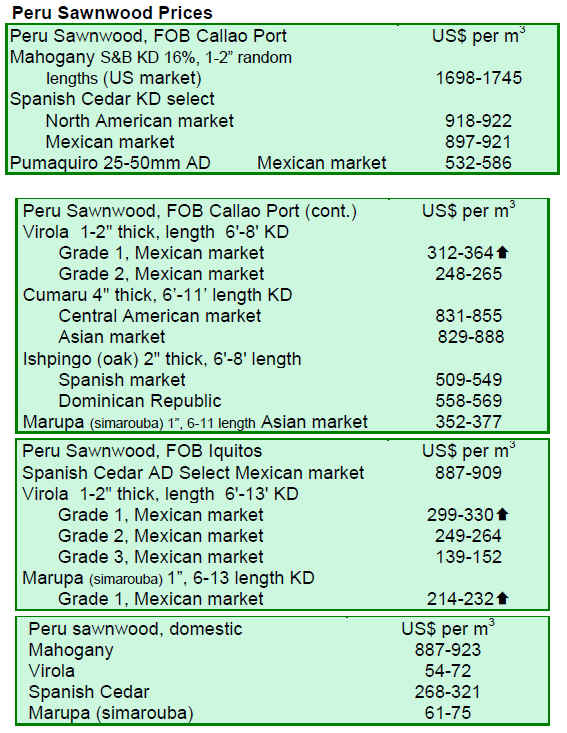
9. Bolivia
Forest product exports
Forest product exports from Bolivia totalled US$85
million in the period from January to May 2010, up 31%
from US$65 million in the same period last year.
Furniture, doors, panels, decking (as well as peeled
chestnut and canned palm hearts) account for 81% of the
total forest product exports, while the remaining 19%
consists of primary processed wood products, such as
sawnwood and poles.
The US remains the major market for Bolivian forest
products taking some US$19.4 million, which accounted
for 23% of the total forest product exports from Bolivia.
Other major export destinations were the UK (US$13.4
million), Venezuela (US$6.7 million), the Netherlands
(US$5.8 million) and China (US$4.9 million).
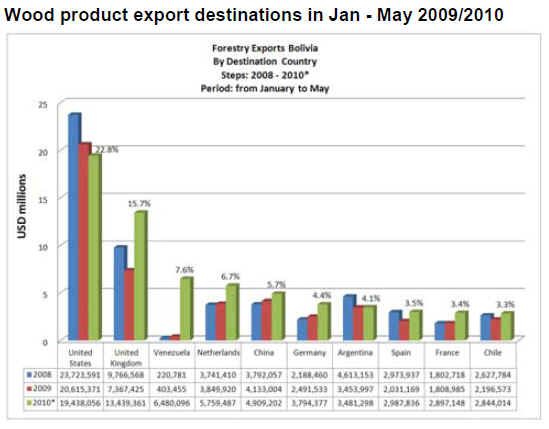

10.
Guyana
Market Trends
During the period under review, there were no exports of
greenheart logs. Prices for purpleheart logs decreased in
all grades while prices for mora logs remained firm. The
slowdown in log exports is due, say analysts, to the active
domestic housing sector which has increased local demand
for processed wood products.
Prices for both dressed and undressed sawnwood gained
during the period under review. Greenheart undressed
sawnwood prices in select and merchantable grades
experienced significant increases to US$730 and US$700
per cu.m respectively. However, mora undressed
sawnwood prices remained stable.
Dressed greenheart prices picked up during this fortnight
period reaching US$996 per cu.m and similarly dressed
sawnwood ipe (Washiba) and undressed red cedar (Cedro)
attracted high average prices of US$1,600 per cu.m and
US$1,009 per cu.m respectively.
Baromalli plywood trade was brisk and prices picked up.
Also splitwood prices were buoyant reaching as high as
US$1,225 per cu.m.
Exports of value added products have been good and this
has contributed significantly to total export earnings. The
products such as handicrafts, doors, outdoor garden
furniture and wooden utensils have been mainly exported
to the Caribbean market. Species used for value-added
products include crabwood, greenheart, kabukalli (Goupia
glabra), red sedar and simarupa (Simaruba amara).
Guyana¡¯s responds to US Lacey Act
The revised US Lacey Act (1 April 2010) includes an
expanded product coverage list covering many of the
products currently exported by Guyana to the US.
The responsibility of ensuring legality rests on the US
importer, however, the exporters are required to document
compliances at every stage of the process from harvest to
export. The test of illegality/legality is done in accordance
with compliance with each country¡¯s laws, in Guyana¡¯s
case, Guyana¡¯s forest laws.
The Guyana Forestry Commission (GFC) in collaboration
with the United States Forest Service and USAID,
facilitated the US Lacey Act expert team. The team made
a mission to Guyana on 13-15 July 2010 to engage with
stakeholders, share information and answer questions
raised over the Act. The team visited four locations across
the country and met with various stakeholders including
exporters, potential exporters, forest concession holders,
sawmillers and different wood product manufacturers.
As part of the implementation of Lacey Act, the GFC has
improved the Guyana¡¯s national log tagging and tracking
system by upgrading it with a bar coding technology. The
GFC outlines that the key concession and environmental
monitoring tools in operation include the Code of Practice
and the log tracking system. Additionally, GFC reports
that it has 25 forest monitoring stations located at strategic
control points across the country and 10 additional mobile
monitoring units. According to the GFC, Guyana has also
developed a Legality Assurance System that will be the
platform to engage with relevant partners and possible
international systems.
In order to improve detection and prevention of illegal
logging and illegality in shipments and trade of wood
products in Guyana, a ¡°Legality, Monitoring and
Extension Unit¡± has been established within the GFC, with
assistance from ITTO. In addition, ITTO has also
supported the GFC in a project aimed at identifying
specific areas for strengthening the national log tracking
system.
Additionally, the GFC has initiated several other
programmes to strengthen forest legality as well as
sustainable forest management in Guyana. The GFC has
expressed that collectively, these systems and procedures
along with others that are being implemented, will give
Guyana¡¯s forest product exporters to the US (and other
destinations with similar legal requirements like the Lacey
Act), a strong basis for continued and improved trade
relations.
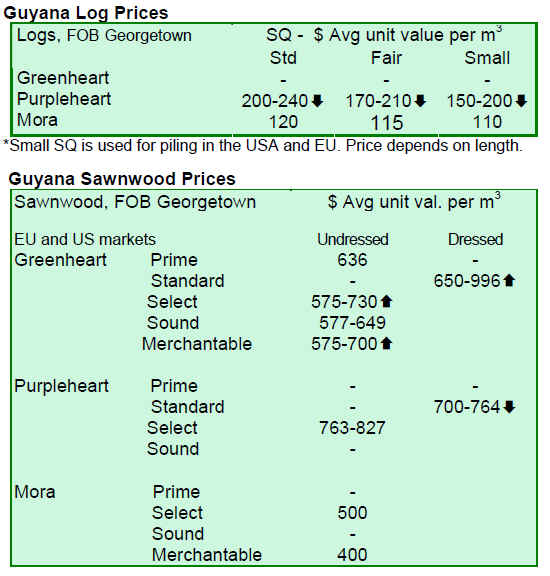
Related News:
|